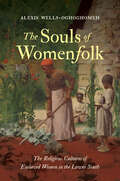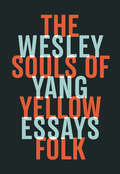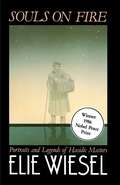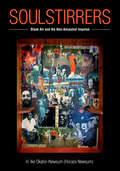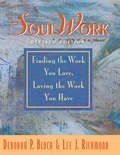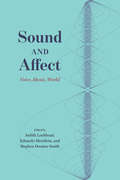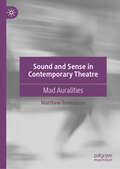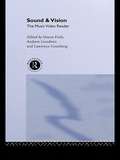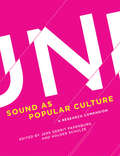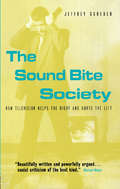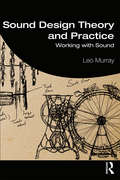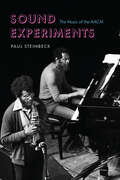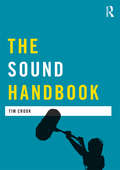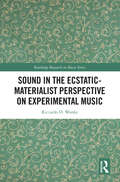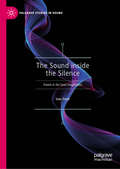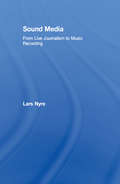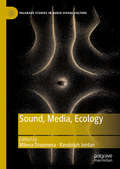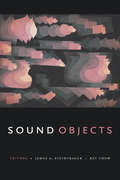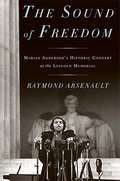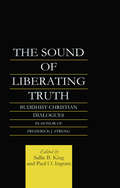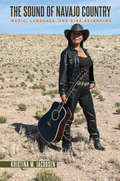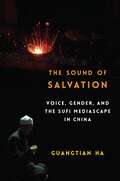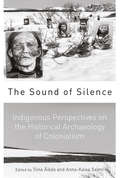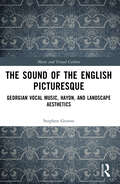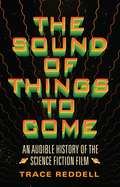- Table View
- List View
The Souls of Womenfolk: The Religious Cultures of Enslaved Women in the Lower South
by Alexis Wells-OghoghomehBeginning on the shores of West Africa in the sixteenth century and ending in the U.S. Lower South on the eve of the Civil War, Alexis Wells-Oghoghomeh traces a bold history of the interior lives of bondwomen as they carved out an existence for themselves and their families amid the horrors of American slavery. With particular attention to maternity, sex, and other gendered aspects of women's lives, she documents how bondwomen crafted female-centered cultures that shaped the religious consciousness and practices of entire enslaved communities. Indeed, gender as well as race co-constituted the Black religious subject, she argues—requiring a shift away from understandings of "slave religion" as a gender-amorphous category.Women responded on many levels—ethically, ritually, and communally—to southern slavery. Drawing on a wide range of sources, Wells-Oghoghomeh shows how they remembered, reconfigured, and innovated beliefs and practices circulating between Africa and the Americas. In this way, she redresses the exclusion of enslaved women from the American religious narrative. Challenging conventional institutional histories, this book opens a rare window onto the spiritual strivings of one of the most remarkable and elusive groups in the American experience.
The Souls of Yellow Folk: Essays
by Wesley YangThe National Magazine Award–winning writer’s debut collection of incisive, stylish essays on race and gender. <p><p> One of the most acclaimed essayists of his generation, Wesley Yang writes about race and sex without the jargon, formulas, and polite lies that bore us all. His powerful debut, The Souls of Yellow Folk, does more than collect a decade’s worth of cult-reputation essays—it corrals new American herds of pickup artists, school shooters, mandarin zombies, and immigrant strivers, and exposes them to scrutiny, empathy, and polemical force. <p> In his celebrated and prescient essay “The Face of Seung-Hui Cho,” Yang explores the deranged logic of the Virginia Tech shooter. In his National Magazine Award–winning “Paper Tigers,” he explores the intersection of Asian values and the American dream, and the inner torment of the child exposed to “tiger mother” parenting. And in his close reading of New York Magazine’s popular Sex Diaries, he was among the first critics to take seriously today’s Internet-mediated dating lives. <p> Yang catches these ugly trends early because he has felt at various times implicated in them, and he does not exempt himself from his radical honesty. His essays retain the thrill of discovery, the wary eye of the first explorer, and the rueful admission of the first exposed.
Souls on Fire: Portraits and Legends of Hasidic Masters
by Elie WieselHassidism, its legends, and masters, has always been a source of mystery and confusion. "Souls on Fire" is a journey through Hassidism. Elie Wiesel travels from the source and further expansion of this unique Jewish religious manifestation.
SoulStirrers: Black Art and the Neo-Ancestral Impulse
by H. Ike Okafor-NewsumIn SoulStirrers, H. Ike Okafor-Newsum describes the birth and development of an artistic movement in Cincinnati, Ohio, identified with the Neo-Ancestral impulse. The Neo-Ancestral impulse emerges as an extension of the Harlem Renaissance, the Negritude Movement, and the Black Arts Movement, all of which sought to re-represent the "primitive" and "savage" black and African in new terms. Central to the dominant racial framework has always been the conception that the black subject was not only inferior, but indeed incapable of producing art. The Neo-Ancestral impulse posed a challenge to both existing form and content. Like its intellectual antecedents, the movement did not separate art from life and raised a central question, one that the "soul stirrers" of Cincinnati are engaging in their artistic productions. Okafor-Newsum defines collapsing of the sacred and the profane as a central tendency of African aesthetics, transformed and rearticulated here in the Americas.In this volume, the artistic productions ask readers to consider the role of those creating and viewing this art by attempting to shift the way in which we view the ordinary. The works of these artists, therefore, are not only about the survival of African-derived cultural forms, though such remains a central effect of them. These extraordinary pieces, installations, and movements consistently refer to the cultural reality of the Americas and the need for political and intellectual transformation. They constitute important intellectual interventions that serve as indispensable elements in the redefinition and reinterpretation of our society.Featuring numerous color illustrations and profiles of artists, this volume reveals exciting trends in African American art and in the African diaspora more broadly.
SoulWork: Finding the Work You Love, Loving the Work You Have
by Deborah P Bloch Lee RichmondWhat programs address career development in an holistic way, including issues of meaning and purpose, spirituality, and 'work within a life'? Written for career planners, executive coaches, life change counselors, HR and human services managers and all those interested in employee development, workplace values, life-career assessment and personal transformation, this book helps to connect your career to the spiritual values that give your life meaning.SoulWork: Finding the Work you Love, Loving the Work relates your career to spiritual themes, and aims to provide advice and support to people in working through their personal choices. Updated from 1998, the revised edition places career choices in the context of holistic, personal, spiritual development and internal change. A spiritual approach to integrating work/career with all life issues. This book examines the concept of careers within the context of seven themes, including chapters on: Change, Balance, Energy, Community, Calling, Harmony, Unity, Exercises Each starts with a story and then offers career issues, reflections on various aspects of the chapter theme and a set of applications that includes self-administered questionnaires and exercises. The authors take a systematic approach, use clear language and examples that many people will be able to relate to. The value of this book lies in its practical focus on the issues of matching work life to life in its totality. It offers an opportunity to reassess one's career and connect it to the spiritual values that bring meaning and depth to one's life.SoulWork offers a refreshingly unconventional approach to the quest for satisfying work. Rather than focusing on matching occupations against personality traits as many other books do, this book advocates finding one's ideal job through one's calling. That is, drawing on strengths, life experiences, personal needs, and goals to arrive at meaningful work.
Sound and Affect: Voice, Music, World
by Judith Lochhead Eduardo Mendieta Stephen Decatur SmithThere is no place on earth that does not echo with the near or distant sounds of human activity. More than half of humanity lives in cities, meaning the daily soundtrack of our lives is filled with sound—whether it be sonorous, harmonious, melodic, syncopated, discordant, cacophonous, or even screeching. This new anthology aims to explore how humans are placed in certain affective attitudes and dispositions by the music, sounds, and noises that envelop us. ?Sound and Affect maps a new territory for inquiry at the intersection of music, philosophy, affect theory, and sound studies. The essays in this volume consider objects and experiences marked by the correlation of sound and affect, in music and beyond: the voice, as it speaks, stutters, cries, or sings; music, whether vocal, instrumental, or machine-made; and our sonic environments, whether natural or artificial, and how they provoke responses in us. Far from being stable, correlations of sound and affect are influenced and even determined by factors as diverse as race, class, gender, and social and political experience. Examining these factors is key to the project, which gathers contributions from a cross-disciplinary roster of scholars, including both established and new voices. This agenda-setting collection will prove indispensable to anyone interested in innovative approaches to the study of sound and its many intersections with affect and the emotions.
Sound and Sense in Contemporary Theatre: Mad Auralities
by Matthew TomkinsonThis book is among the first to consider the subject of mad auralities in theatre and performance, asking: what does it mean to hear and listen madly? Drawing widely upon mad studies, critical disability studies, theatre studies, sound studies, queer studies, and critical race theory, it seeks to explore the theatrical relationship between sound and mental health differences by examining a range of case studies in which audience members are immersed in auditory simulations of madness. Ultimately, however, this critical study investigates the shortcomings of simulation as a representational practice, in keeping with the critical tradition of disability studies and mad studies.
Sound and Vision: The Music Video Reader
by Simon Frith Lawrence Grossberg Andrew GoodwinSound and Vision is the first significant collection of new and classic texts on video and brings together some of the leading international cultural and music critics writing today. Addressing one of the most controversial forms of popular culture in the contemporary world, Sound and Vision confronts easy interpretations of music video - as promotional vehicles, filmic images and postmodern culture - to offer a new and bold understanding of its place in pop music, television and the media industries. The book acknowledges the history of the commercial status of pop music as a whole, as well as its complex relations with other media. Sound and Vision will be an essential text for students of popular music and popular culture.
Sound as Popular Culture: A Research Companion
by Jens Gerrit Papenburg Holger SchulzeScholars consider sound and its concepts, taking as their premise the idea that popular culture can be analyzed in an innovative way through sound.The wide-ranging texts in this book take as their premise the idea that sound is a subject through which popular culture can be analyzed in an innovative way. From an infant's gurgles over a baby monitor to the roar of the crowd in a stadium to the sub-bass frequencies produced by sound systems in the disco era, sound—not necessarily aestheticized as music—is inextricably part of the many domains of popular culture. Expanding the view taken by many scholars of cultural studies, the contributors consider cultural practices concerning sound not merely as semiotic or signifying processes but as material, physical, perceptual, and sensory processes that integrate a multitude of cultural traditions and forms of knowledge.The chapters discuss conceptual issues as well as terminologies and research methods; analyze historical and contemporary case studies of listening in various sound cultures; and consider the ways contemporary practices of sound generation are applied in the diverse fields in which sounds are produced, mastered, distorted, processed, or enhanced. The chapters are not only about sound; they offer a study through sound—echoes from the past, resonances of the present, and the contradictions and discontinuities that suggest the future.ContributorsKarin Bijsterveld, Susanne Binas-Preisendörfer, Carolyn Birdsall, Jochen Bonz, Michael Bull, Thomas Burkhalter, Mark J. Butler, Diedrich Diederichsen, Veit Erlmann, Franco Fabbri, Golo Föllmer, Marta García Quiñones, Mark Grimshaw, Rolf Großmann, Maria Hanáček, Thomas Hecken, Anahid Kassabian, Carla J. Maier, Andrea Mihm, Bodo Mrozek, Carlo Nardi, Jens Gerrit Papenburg, Thomas Schopp, Holger Schulze, Toby Seay, Jacob Smith, Paul Théberge, Peter Wicke, Simon Zagorski-Thomas
The Sound Bite Society: How Television Helps the Right and Hurts the Left
by Jeffrey ScheuerFirst Published in 2002. Routledge is an imprint of Taylor & Francis, an informa company.
Sound Design Theory and Practice: Working with Sound
by Leo MurraySound Design Theory and Practice is a comprehensive and accessible guide to the concepts which underpin the creative decisions that inform the creation of sound design. A fundamental problem facing anyone wishing to practice, study, teach or research about sound is the lack of a theoretical language to describe the way sound is used and a comprehensive and rigorous overarching framework that describes all forms of sound. With the recent growth of interest in sound studies, there is an urgent need to provide scholarly resources that can be used to inform both the practice and analysis of sound. Using a range of examples from classic and contemporary cinema, television and games this book provides a thorough theoretical foundation for the artistic practice of sound design, which is too frequently seen as a ‘technical’ or secondary part of the production process. Engaging with practices in film, television and other digital media, Sound Design Theory and Practice provides a set of tools for systematic analysis of sound for both practitioners and scholars.
Sound Experiments: The Music of the AACM
by Paul SteinbeckA groundbreaking study of the trailblazing music of Chicago’s AACM, a leader in the world of jazz and experimental music. Founded on Chicago’s South Side in 1965 and still thriving today, the Association for the Advancement of Creative Musicians (AACM) is the most influential collective organization in jazz and experimental music. In Sound Experiments, Paul Steinbeck offers an in-depth historical and musical investigation of the collective, analyzing individual performances and formal innovations in captivating detail. He pays particular attention to compositions by Muhal Richard Abrams and Roscoe Mitchell, the Association’s leading figures, as well as Anthony Braxton, George Lewis (and his famous computer-music experiment, Voyager), Wadada Leo Smith, and Henry Threadgill, along with younger AACM members such as Mike Reed, Tomeka Reid, and Nicole Mitchell. Sound Experiments represents a sonic history, spanning six decades, that affords insight not only into the individuals who created this music but also into an astonishing collective aesthetic. This aesthetic was uniquely grounded in nurturing communal ties across generations, as well as a commitment to experimentalism. The AACM’s compositions broke down the barriers between jazz and experimental music and made essential contributions to African American expression more broadly. Steinbeck shows how the creators of these extraordinary pieces pioneered novel approaches to instrumentation, notation, conducting, musical form, and technology, creating new soundscapes in contemporary music.
The Sound Handbook (Media Practice)
by Tim Crook'Tim Crook has written an important and much-needed book, and its arrival on our shelves has come at a highly appropriate time.' Professor Seán Street, Bournemouth University The Sound Handbook maps theoretical and practical connections between the creation and study of sound across the multi-media spectrum of film, radio, music, sound art, websites, animation and computer games entertainment, and stage theatre. Using an interdisciplinary approach Tim Crook explores the technologies, philosophies and cultural issues involved in making and experiencing sound, investigating soundscape debates and providing both intellectual and creative production information. The book covers the history, theory and practice of sound and includes practical production projects and a glossary of key terms. The Sound Handbook is supported by a companion website, signposted throughout the book, with further practical and theoretical resources dedicated to bridging the creation and study of sound across professional platforms and academic disciplines.
Sound in the Ecstatic-Materialist Perspective on Experimental Music (Routledge Research in Music)
by Riccardo D. WankeWhat does a one hour contemporary orchestral piece by Georg Friedrich Haas have in common with a series of glitch-noise electronic tracks by Pan Sonic? This book proposes that, despite their differences, they share a particular understanding of sound that is found across several quite distinct genres of contemporary art music: the ecstatic-materialist perspective. Sound in the ecstatic-materialist perspective is considered as a material mass or element, unfolding in time, encountered by a listener, for whom the experience of that sound exceeds the purely sonic without becoming entirely divorced from its materiality. It is "material" by virtue of the focus on the texture, consistency, and density of sound; it is "ecstatic" in the etymological sense, that is to say that the experience of this sound involves an instability; an inclination to depart from material appearance, an ephemeral and transitory impulse in the very perception of sound to something beyond – but still related to – it. By examining musical pieces from spectralism to electroacoustic domains, from minimalism to glitch electronica and dubstep, this book identifies the key intrinsic characteristics of this musical perspective. To fully account for this perspective on sonic experience, listener feedback and interviews with composers and performers are also incorporated. Sound in the ecstatic-materialist perspective is the common territory where composers, sound artists, performers, and listeners converge.
The Sound inside the Silence: Travels in the Sonic Imagination (Palgrave Studies in Sound)
by Seán StreetIn this poetic exploration of the auditory imagination, the third in his series on sonic aesthetics, Seán Street peoples silence with sound, travelling through time and space to the distant past, the infinite future and the shadow lands of the inner psyche. Our mind is a canvas on which the colours of the sound world leave permanent impressions. It is the root of all listening.
Sound Media: From Live Journalism to Music Recording
by Lars NyreSound Media considers how music recording, radio broadcasting and muzak influence people's daily lives and introduces the many and varied creative techniques that have developed in music and journalism throughout the twentieth century. Lars Nyre starts with the contemporary cultures of sound media, and works back to the archaic soundscapes of the 1870s. The first part of the book devotes five chapters to contemporary digital media, and presents the internet, the personal computer, digital radio (news and talk) and various types of loudspeaker media (muzak, DJ-ing, clubbing and PA systems). The second part examines the historical accumulation of techniques and sounds in sound media, and presents multitrack music in the 1960s, the golden age of radio in the 1950s and back to the 1930s, microphone recording of music in the 1930s, the experimental phase of wireless radio in the 1910s and 1900s, and the invention of the gramophone and phonograph in the late nineteenth century. Sound Media includes a soundtrack CD with thirty-six examples from broadcasting and music recording in Europe and the USA, from Edith Piaf to Sarah Cox, and is richly illustrated with figures, timelines and technical drawings.
Sound, Media, Ecology (Palgrave Studies in Audio-Visual Culture)
by Milena Droumeva Randolph JordanThis volume reads the global urban environment through mediated sonic practices to put a contemporary spin on acoustic ecology’s investigations at the intersection of space, cultures, technology, and the senses. Acoustic ecology is an interdisciplinary framework from the 1970s for documenting, analyzing, and transforming sonic environments: an early model of the cross-boundary thinking and multi-modal practices now common across the digital humanities. With the recent emergence of sound studies and the expansion of “ecological” thinking, there is an increased urgency to re-discover and contemporize the acoustic ecology tradition. This book serves as a comprehensive investigation into the ways in which current scholars working with sound are re-inventing acoustic ecology across diverse fields, drawing on acoustic ecology’s focus on sensory experience, place, and applied research, as well as attendance to mediatized practices in sounded space. From sounding out the Anthropocene, to rethinking our auditory media landscapes, to exploring citizenship and community, this volume brings the original acoustic ecology problem set into the contemporary landscape of sound studies.
Sound Objects
by James A. Steintrager Rey ChowIs a sound an object, an experience, an event, or a relation? What exactly does the emerging discipline of sound studies study? Sound Objects pursues these questions while exploring how history, culture, and mediation entwine with sound’s elusive objectivity. Examining the genealogy and evolution of the concept of the sound object, the commodification of sound, acousmatic listening, nonhuman sounds, and sound and memory, the contributors not only probe conceptual issues that lie in the forefront of contemporary sonic discussions but also underscore auditory experience as fundamental to sound as a critical enterprise. In so doing, they offer exciting considerations of sound within and beyond its role in meaning, communication, and information and an illuminatingly original theoretical overview of the field of sound studies itself. Contributors. Georgina Born, Michael Bull, Michel Chion, Rey Chow, John Dack, Veit Erlmann, Brian Kane, Jairo Moreno, John Mowitt, Pooja Rangan, Gavin Steingo, James A. Steintrager, Jonathan Sterne, David Toop
The Sound of Freedom: Marian Anderson, the Lincoln Memorial, and the Concert that Awakened America
by Raymond ArsenaultAward-winning civil rights historian Ray Arsenault describes the dramatic story behind Marian Anderson's concert at the Lincoln Memorial--an early milestone in civil rights history--on the seventieth anniversary of her performance. On Easter Sunday 1939, the brilliant vocalist Marian Anderson sang before a throng of seventy-five thousand at the Lincoln Memorial in Washington--an electrifying moment and an underappreciated milestone in civil rights history. Though she was at the peak of a dazzling career, Anderson had been barred from performing at the Daughters of the American Revolution's Constitution Hall because she was black. When Eleanor Roosevelt resigned from the DAR over the incident and took up Anderson's cause, however, it became a national issue. Like a female Jackie Robinson--but several years before his breakthrough--Anderson rose to a pressure-filled and politically charged occasion with dignity and courage, and struck a vital blow for civil rights. In the 1963 March on Washington, Martin Luther King would follow, literally, in Anderson's footsteps. This tightly focused, richly textured narrative by acclaimed historian Raymond Arsenault captures the struggle for racial equality in 1930s America, the quiet heroism of Marian Anderson, and a moment that inspired blacks and whites alike. You can find this concert on YouTube.
The Sound of Liberating Truth: Buddhist-Christian Dialogues in Honor of Frederick J. Streng (Routledge Critical Studies in Buddhism #Vol. 12)
by Paul Ingram Sallie B. KingOffers essays and dialogues by well-known Buddhist and Christian scholars on topics that were of primary interest to Frederick J. Streng, in whose honour the volume was created. Topics include interreligious dialogue, ultimate reality, nature and ecology, social and political issues of liberation, and ultimate transformation or liberation.
The Sound of Navajo Country: Music, Language, and Diné Belonging (Critical Indigeneities)
by Kristina M. JacobsenIn this ethnography of Navajo (Diné) popular music culture, Kristina M. Jacobsen examines questions of Indigenous identity and performance by focusing on the surprising and vibrant Navajo country music scene. Through multiple first-person accounts, Jacobsen illuminates country music’s connections to the Indigenous politics of language and belonging, examining through the lens of music both the politics of difference and many internal distinctions Diné make among themselves and their fellow Navajo citizens. As the second largest tribe in the United States, the Navajo have often been portrayed as a singular and monolithic entity. Using her experience as a singer, lap steel player, and Navajo language learner, Jacobsen challenges this notion, showing the ways Navajos distinguish themselves from one another through musical taste, linguistic abilities, geographic location, physical appearance, degree of Navajo or Indian blood, and class affiliations. By linking cultural anthropology to ethnomusicology, linguistic anthropology, and critical Indigenous studies, Jacobsen shows how Navajo poetics and politics offer important insights into the politics of Indigeneity in Native North America, highlighting the complex ways that identities are negotiated in multiple, often contradictory, spheres.
The Sound of Salvation: Voice, Gender, and the Sufi Mediascape in China (Studies of the Weatherhead East Asian Institute, Columbia University)
by Guangtian HaThe Jahriyya Sufis—a primarily Sinophone order of Naqshbandiyya Sufism in northwestern China—inhabit a unique religious soundscape. The hallmark of their spiritual practice is the “loud” (jahr) remembrance of God in liturgical rituals featuring distinctive melodic vocal chants.The first ethnography of this order in any language, The Sound of Salvation draws on nearly a decade of fieldwork to reveal the intricacies and importance of Jahriyya vocal recitation. Guangtian Ha examines how the use of voice in liturgy helps the Jahriyya to sustain their faith and the ways it has enabled them to endure political persecution over the past two and a half centuries. He situates the Jahriyya in a global multilingual network of Sufis and shows how their characteristic soundscapes result from transcultural interactions among Middle Eastern, Central Asian, and Chinese Muslim communities. Ha argues that the resilience of Jahriyya Sufism stems from the diversity and multiplicity of liturgical practice, which he shows to be rooted in notions of Sufi sainthood. He considers the movement of Jahriyya vocal recitation to new media forms and foregrounds the gendered opposition of male voices and female silence that structures the group’s rituals.Spanning diverse disciplines—including anthropology, ethnomusicology, Islamic studies, sound studies, and media studies—and using Arabic, Persian, and Chinese sources, The Sound of Salvation offers new perspectives on the importance of sound to religious practice, the role of gender in Chinese Islam, and the links connecting Chinese Muslims to the broader Islamic world.
The Sound of Silence: Indigenous Perspectives on the Historical Archaeology of Colonialism
by Tiina Äikäs Anna-Kaisa SalmiColonial encounters between indigenous peoples and European state powers are overarching themes in the historical archaeology of the modern era, and postcolonial historical archaeology has repeatedly emphasized the complex two-way nature of colonial encounters. The volume examines common trajectories in indigenous colonial histories, and explores new ways to understand cultural contact, hybridization and power relations between indigenous peoples and colonial powers from the indigenous point of view. By bringing together a wide geographical range and combining multiple sources such as oral histories, historical record, and contemporary discourses with archaeological data, the volume finds new multivocal interpretations of colonial histories.
The Sound of the English Picturesque: Georgian Vocal Music, Haydn, and Landscape Aesthetics (Music and Visual Culture)
by Stephen GrovesRevealing the connections between the veneration of national landscape and eighteenth- century English vocal music, this study restores English music’s relationship with the picturesque. In the eighteenth century, the emerging taste for the picturesque was central to British aesthetics, as poets and painters gained popularity by glorifying the local landscape in works concurrent with the emergence of native countryside tourism. Yet English music was seldom discussed as a medium for conveying national scenic beauty. Stephen Groves explores this gap, and shows how secular song, the glee, and national theatre music expressed a uniquely English engagement with landscape. Using an interdisciplinary approach, Groves addresses the apparent ‘silence’ of the English picturesque. The book draws on analysis of the visualisations present in the texts of English vocal music, and their musical treatment, to demonstrate how local composers incorporated celebrations of landscape into their works. The final chapter shows that the English picturesque was a crucial influence on Joseph Haydn’s oratorio The Seasons. Suitable for anyone with an interest in eighteenth- century music, aesthetics, and the natural environment, this book will appeal to a wide range of specialists and non- specialists alike.
The Sound of Things to Come: An Audible History of the Science Fiction Film
by Trace ReddellA groundbreaking approach to sound in sci-fi films offers new ways of construing both sonic innovation and science fiction cinema Including original readings of classics like The Day the Earth Stood Still, 2001: A Space Odyssey, Star Wars, and Blade Runner, The Sound of Things to Come delivers a comprehensive history of sound in science fiction cinema. Approaching movies as sound objects that combine cinematic apparatus and consciousness, Trace Reddell presents a new theory of sonic innovation in the science fiction film.Reddell assembles a staggering array of movies from sixty years of film history—including classics, blockbusters, B-movies, and documentaries from the United States, Britain, France, Germany, Japan, and the Soviet Union—all in service to his powerful conception of sound making as a speculative activity in its own right. Reddell recasts debates about noise and music, while arguing that sound in the science fiction film provides a medium for alien, unknown, and posthuman sound objects that transform what and how we hear.Avoiding genre criticism&’s tendency to obsess over utopias, The Sound of Things to Come draws on film theory, sound studies, and philosophies of technology to advance conversations about the avant-garde, while also opening up opportunities to examine cinematic sounds beyond the screen.
